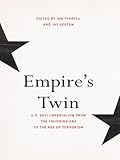Empire's Twin : U.S. Anti-imperialism from the Founding Era to the Age of Terrorism / ed. by Jay Sexton, Ian Tyrrell.
Material type: TextSeries: The United States in the WorldPublisher: Ithaca, NY : Cornell University Press, [2015]Copyright date: ©2015Description: 1 online resource (312 p.)Content type:
TextSeries: The United States in the WorldPublisher: Ithaca, NY : Cornell University Press, [2015]Copyright date: ©2015Description: 1 online resource (312 p.)Content type: - 9780801455704
- 325/.320973 23
- online - DeGruyter
| Item type | Current library | Call number | URL | Status | Notes | Barcode | |
|---|---|---|---|---|---|---|---|
 eBook
eBook
|
Biblioteca "Angelicum" Pont. Univ. S.Tommaso d'Aquino Nuvola online | online - DeGruyter (Browse shelf(Opens below)) | Online access | Not for loan (Accesso limitato) | Accesso per gli utenti autorizzati / Access for authorized users | (dgr)9780801455704 |
Frontmatter -- Contents -- Acknowledgments -- Introduction -- PART I CONQUEST AND ANTICOLONIALISM IN THE NINETEENTH CENTURY -- 1. Imperialism and Nationalism in the Early American Republic -- 2. Native Americans against Empire and Colonial Rule -- 3. “The Imperialism of the Declaration of Independence” in the Civil War Era -- PART II ANTI-IMPERIALISM AND THE NEW AMERICAN EMPIRE -- 4. Anti-imperialism in the U.S. Territories after 1898 -- 5. U.S. Anti-imperialism and the Mexican Revolution -- 6. Anti-imperialism, Missionary Work, and the King-Crane Commission -- PART III THE EXTENT AND LIMITS OF ANTI-IMPERIALISM -- 7. Global Anti-imperialism in the Age of Wilson -- 8. Feminist Historiography, Anti-imperialism, and the Decolonial -- 9. Resource Use, Conservation, and the Environmental Limits of Anti-imperialism, c. 1890–1930 -- PART IV ANTI-IMPERIALISM IN THE AGE OF AMERICAN POWER -- 10. Promoting American Anti-imperialism in the Early Cold War -- 11. Ruling-Class Anti-imperialism in the Era of the Vietnam War -- 12. Whither American Anti-imperialism in a Postcolonial World? -- Notes -- Contributors -- Index
restricted access online access with authorization star
http://purl.org/coar/access_right/c_16ec
Across the course of American history, imperialism and anti-imperialism have been awkwardly paired as influences on the politics, culture, and diplomacy of the United States. The Declaration of Independence, after all, is an anti-imperial document, cataloguing the sins of the metropolitan government against the colonies. With the Revolution, and again in 1812, the nation stood against the most powerful empire in the world and declared itself independent. As noted by Ian Tyrrell and Jay Sexton, however, American "anti-imperialism was clearly selective, geographically, racially, and constitutionally." Empire’s Twin broadens our conception of anti-imperialist actors, ideas, and actions; it charts this story across the range of American history, from the Revolution to our own era; and it opens up the transnational and global dimensions of American anti-imperialism.By tracking the diverse manifestations of American anti-imperialism, this book highlights the different ways in which historians can approach it in their research and teaching. The contributors cover a wide range of subjects, including the discourse of anti-imperialism in the Early Republic and Civil War, anti-imperialist actions in the U.S. during the Mexican Revolution, the anti-imperial dimensions of early U.S. encounters in the Middle East, and the transnational nature of anti-imperialist public sentiment during the Cold War and beyond.
Mode of access: Internet via World Wide Web.
In English.
Description based on online resource; title from PDF title page (publisher's Web site, viewed 26. Apr 2024)


